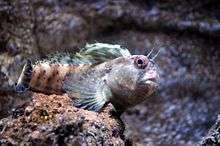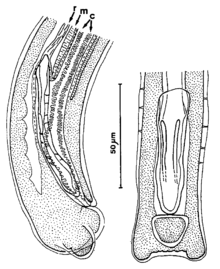Tompot blenny
The tompot blenny (Parablennius gattorugine) is a species of combtooth blenny from the north eastern Atlantic Ocean which is found in shallow, coastal waters off western Europe, the Mediterranean and North Africa.
| Tompot blenny | |
|---|---|
 | |
| Scientific classification | |
| Kingdom: | Animalia |
| Phylum: | Chordata |
| Class: | Actinopterygii |
| Order: | Blenniiformes |
| Family: | Blenniidae |
| Genus: | Parablennius |
| Species: | P. gattorugine |
| Binomial name | |
| Parablennius gattorugine | |
| Synonyms | |
Description
The tompot blenny is a relatively large blenny with an elongated body, large head and large eyes[2] which grows to up to 30 centimetres (12 in) in length. The eyes are bicoloured with their top part being brown and the bottom part is white.[3] There is a single branched tentacle over each of its eyes. It is mainly yellow-brown in colour, although occasionally it is greenish and is marked with at least seven dark bars starting at the dorsal fin and which reach the belly.[4] As well as the tentacles over the eyes there are also tentacles over the nostrils. The lateral line is continuous but becomes broken towards the tail. The breeding males become chocolate brown in colour and develop bulb-like glands on the spines of the anal fin. The dorsal fin runs the length of its body and is divided into two halves by a shallow notch. The anterior portion of the fin is contains the spiny rays while the posterior portion contains the soft rays.[3] The dorsal fin has 13-14 spines and 17-20 ray while the anal fin has 2 spines and 19-23 rays.[5] It has relatively large pectoral fins.[6] Each individual has a unique set of markings on the scales of the face which mean that studies of their biology can identify individuals.[7]
Distribution
The tompot blenny is found along the Atlantic coast of Europe from southern England and Ireland to Morocco.[5] It is also found throughout the Mediterranean Sea to the Sea of Marmara and the Black Sea.[1] In Great Britain it is mainly recorded off the south and west coasts and is largely absent from the North Sea coasts, although it has been seen on wrecks off the North Norfolk coast.[3][8] and off eastern Scotland as far north as the Shetland Islands.[4]

Habitat and biology
Habitat
Tompot blennies are very territorial and their territories are centred around a crevice in the rocky reef which the fish uses for shelter.[2] They occur in shallow seas at depths of 3–32 metres (9.8–105.0 ft)[4] although smaller specimens occur in rockpools.[2] They may be found above the low tide mark at very low tides, sheltering under boulders or among exposed vegetation.[4]
Feeding
Tompot blennies have sharp, comb-like teeth which they use to scrape food from the substrate. They feed on sea anemones[2] and on other invertebrates[6] such as prawns and other crustaceans.[9] They are crepuscular, being active mainly at dawn and at dusk.[5]
Parasites
As most fish, tompot blennies harbour several species of parasites, including the capillariid Nematode Pseudocapillaria bainae. This parasite has been found in the intestine of specimens caught off Italy and Montenegro.[10] Its biology is unknown.[11]
Breeding
Tompot blennies spawn in March to May the males mate with a number of females and guards their eggs. The eggs are demersal and like those of all blennies they stick to the substrate by a filamentous adhesive patch. The male guards the eggs until the larvae hatch, usually about a month after laying.[5] The males defend their territories from other males and often fight each other, frequently receiving injuries. When breeding the males develop pale cauliflower like glands on their anal fins which are believed to play a role in attracting females and in cleaning the eggs.[7]
Name
The specific name was first used by Francis Willughby in 1688 after he had observed these blennies in Venice and heard them called gatto ruggine which he translated as "rusty cat" or "rust colour", although he was afraid that he did not fully understand the name. However the actual name is gatto rusola or gotto rosula which is a local name for blennies in general along the Adriatic coast of Italy and which is a diminutive of gotto roso meaning "thick throat".[12]
Miscellany
In the mid-1990s there was a minor acoustic indie-folk band called Tompot Blenny,[9] who released a few E.P.s in the 1990s and a full album called Found under Blankets in 2000.[13]
References
- Di Natale, A.; Bilecenoglu, M.; Bariche, M.; et al. (2011). "Parablennius gattorugine (errata version published in 2016)". IUCN Red List of Threatened Species. 2011: e.T185128A86636193. doi:10.2305/IUCN.UK.2011-2.RLTS.T185128A8360957.en.{{cite iucn}}: error: |doi= / |page= mismatch (help)
- "Tompot Blenny". The Wildlife Trusts. Retrieved 17 March 2019.
- B. E. Picton & C. C. Morrow (2010). "Parablennius gattorugine (Linnaeus, 1758)". Encyclopedia of Marine Life of Britain and Ireland. National Museums Northern Ireland. Retrieved February 1, 2011.
- Ager, O.E.D. (2008). Tyler-Walters H.; Hiscock K. (eds.). "Parablennius gattorugine Tompot blenny". Marine Life Information Network: Biology and Sensitivity Key Information Reviews, [on-line]. Plymouth. Marine Biological Association of the United Kingdom. Retrieved 17 March 2019.
- Froese, Rainer and Pauly, Daniel, eds. (2019). "Parablennius gattorugine" in FishBase. February 2019 version.
- "Tompot Blenny". British Marine Life Study Society. Retrieved 17 March 2019.
- "The small fish with a big personality: Study reveals unique blenny behaviour – in pictures". The Guardian. 23 March 2016. Retrieved 17 March 2019.
- "New protection for marine wildlife". North Norfolk News. November 12, 2009. Retrieved February 1, 2011.
- "Tompot blenny". British Sea Fishing. Retrieved 17 March 2019.
- Justine, J.-L. & Radujković, B. M. (1988). Capillaria bainae n. sp. (Nematoda: Capillariinae) parasite du Poisson Parablennius gattorugine en mer Adriatique. Bulletin du Muséum national d'Histoire naturelle. Paris, 4° Série, 10 (A), 15-24.
- Moravec, F. (2001). Trichinelloid nematodes parasitic in cold-blooded vertebrates. Praha: Academia. ISBN 80-200-0805-5
- Christopher Scharpf; Kenneth J. Lazara (26 October 2018). "Order BLENNIIFORMES: Family BLENNIIDAE". The ETYFish Project Fish Name Etymology Database. Christopher Scharpf and Kenneth J. Lazara. Retrieved 17 March 2019.
- Stephen Mason. "Tompot Blenny". Allmusic. Retrieved 17 March 2019.
External links


- Photos of Tompot blenny on Sealife Collection
